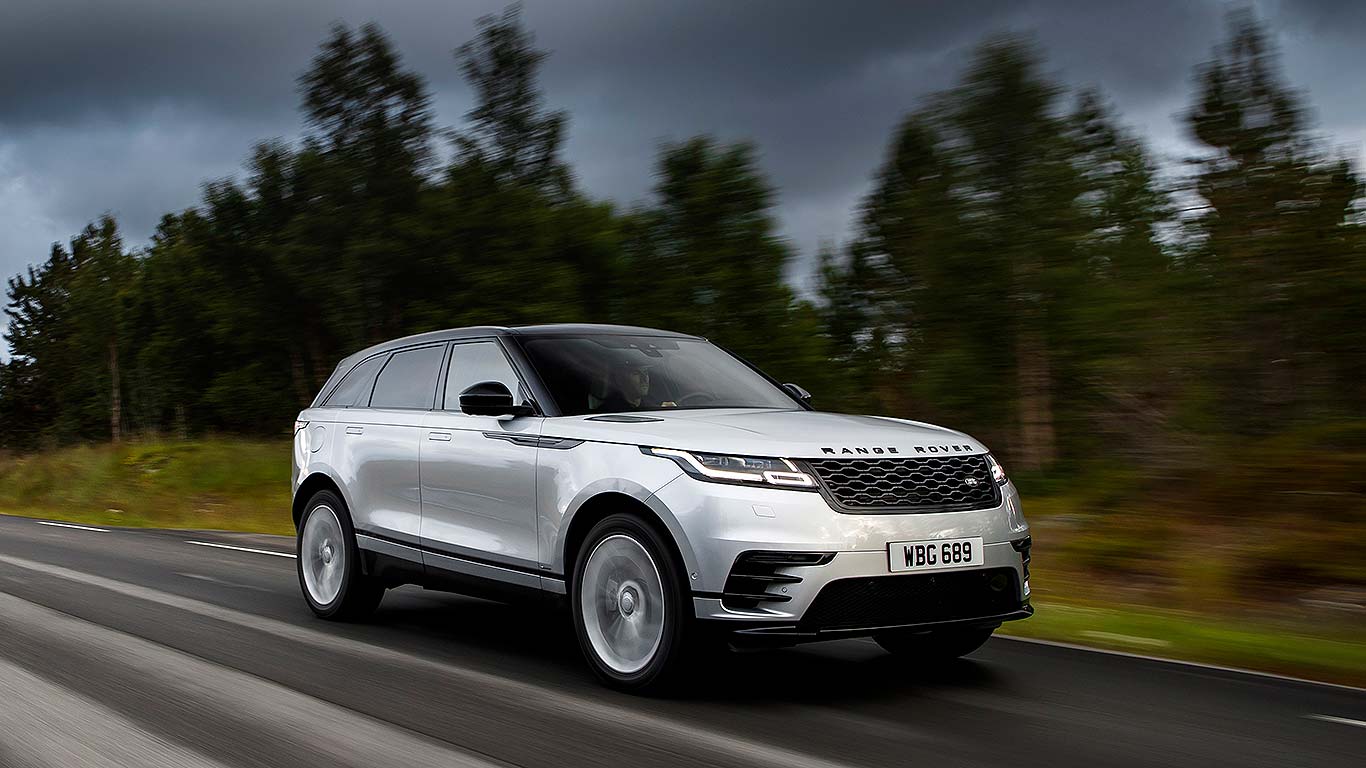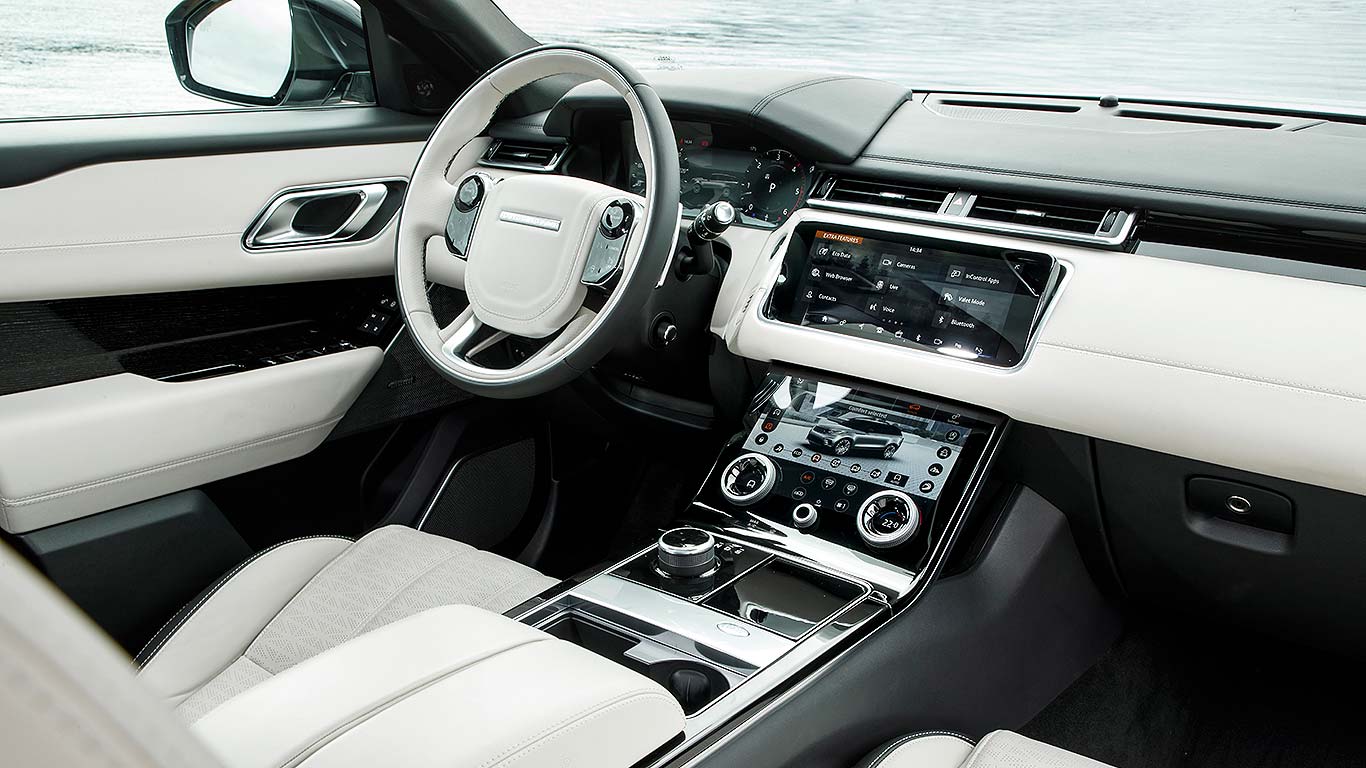 The Range Rover Velar is an all-new Land Rover. They don’t come along every day. Bosses call it a ‘white space’ model, one filling the gap between the Evoque and Range Rover Sport.
The Range Rover Velar is an all-new Land Rover. They don’t come along every day. Bosses call it a ‘white space’ model, one filling the gap between the Evoque and Range Rover Sport.
For some, it seems, the Evoque is too cheap, the Sport too dear. And there are potentially a lot of them: in the UK alone, full year sales should be above 13,000 (Sport) and below 20,000 (Evoque). Not bad for a vehicle that starts at £44,830. Most will likely cost £60,000 or more.
It shares an aluminium-intensive architecture with the Jaguar F-Pace, a car so talented, it’s the reigning World Car of the Year. Beautiful reductionist styling gives the Velar a quite beautiful, graceful appearance, like a concept car inspired by a speedboat making it through to production. It’s bigger than the Evoque, but not too big: shorter than a Ford Mondeo, points out UK MD Jeremy Hicks. In similarly beautiful Norway, we had our first drive of the likely new Range Rover hit.
Range Rover Velar on Motoring Research
We knew when we first saw it the Velar’s interior was something special. A generational step on, it is more advanced and has more tactile clout even than the Range Rover itself, a slightly awkward problem for Land Rover it won’t be too upset to have. It’s modern, interesting, wonderfully crafted, different and gorgeous. Materials quality is boutique-level luxurious. It’s a modern car interior of the highest order.

Particularly as it’s backed up by superb new infotainment systems. They’re Apple-like in their appearance and functionality which, given how woefully off the pace JLR infotainment systems were just a few years ago, is extraordinary. Most will come with a TFT instrument pack, which is getting a familiar sight these days, but is no less novel in its appeal. The central upper TFT touchscreen is also crisp, clear, quick and easy.
The real standout is the lower touchscreen, built into a curving blackpanel structure with world class craftsmanship. This controls audio, climate control, Terrain Response and, frankly, looks stunning. It’s easy to use. If you’re not touching it, your passenger will be. It’s the cherry on the top of a glorious interior.
The Velar is roomy too. Rear seats have legroom, comfort, a nice view out, reclining backrests (reclined by a switch owners of 1990s Fords will recognise, amusingly). Add in, as we’ll see, top notch refinement and the commanding high-up SUV stance Land Rover knows better than anyone, and you’ve a machine the kids will nag and nag non-stop for you to buy.
Mindful of the lifestyle sorts who’ll likely buy so many Velar, the boot is huge too – long, wide, square. 632 litres with the seats up, 1732 litres with them down. If you like mountain biking or doing stuff in water, the JLR Activity Key is offered: chuck the fancy keyfob in the glovebox and lock the car via a waterproof wristband you can’t lose. MAMILs, it’s made for you.
The interior is such a spectacle, I’m glad my driving partner has gone AWOL. It gives me 15 minutes to see the Velar’s cabin live and fully functioning for the first time. As I approach, the concealed doorhandles whirr out. We’re at a noisy airport: I climb up, shut the door, and… silence. A light, airy panoramic view out of noisy jets I can barely hear. And I barely know where to start, there’s so much eye candy here. Gorgeous leather, gloss surface inlays with a Bentley-like sheen, overall design that is new and fresh and interesting.
That’s all before I press the starter button. So I do, and the cabin comes to life, and I’m happy nobody still knows where my driving partner is. The instrument screen in front of me pops, the central display gleams, but my eyes are on the lower one. Like a smartphone, I can’t stop touching it, rushing through its functions as fast as the ultra-fast Ethernet connectivity will allow me. Some people, I guarantee, will buy a Velar simply because of this. I’d be one of them.
Reluctantly, I have to stop. My driving partner appears. I’ve called shotgun so will be first behind the wheel. He can have his own induction to the Velar’s many treats (we barely speak for the first 20 minutes). First up is the 300-horsepower 3.0-litre V6 diesel, a likely favourite in the UK. With a slight diesel clatter and throb, it’s been ticking away in the background (this engine isn’t known for its at-rest isolation). Now it’s time to try out the Velar driving experience so many will enjoy.
The engine murmurs, the eight-speed gearbox slurs, and as we dive onto the highway, it feels there’s lots of effortless pull available. 0-60mph takes 6.1 seconds, more than adequate. It’s the ride and refinement and agreeability that stand out. The F-Pace is sporty and punchy; the Velar is all Range Rover, with cushioned, gliding elegance and a wafting quietness. Splendid isolation, even if the quick steering’s initial dartiness takes a bit of getting used to (its nervousness fades later on).
High-power V6 Velar get air suspension as standard. The First Edition test car – to be made just for a year – is wearing 22-inch wheels. Generally, the suspension hides the worst of what the wheels can do for ride quality, but crashes and cracks can still show through. The impact isn’t so intrusive in town, but can cause a grimace on bad roads at speed. I’d later discover 21-inch wheels are near-perfect: resist the looks and go for them is my advice.
As speeds rise (not too much: we are in Norway, after all), the Velar’s character emerges. A lush, flowing form of transport that’s quiet and refined, well-bred and dignified. It’s modern: effortless, doesn’t roll or wallow, everything comes easy, with lots going on in the background you’re barely aware of. It’s happy to leave all the driver-focused interactivity to Jaguar. Sophisticates, it’s one for you.

Through twists and turns, the steering is accurate and the suspension largely roll-free. It’s big but not too wide, so you can steer it without breathing in too many times. The surge of the diesel engine is the tiniest accelerator-tweak away. It doesn’t make you tingle with floods of feedback in bends, but hangs on perfectly and never causes a fuss.
It’s driver swap time. A grin, as the suspension auto-lowers when we turn it off, to help making getting out and in easier. Now’s my turn to have another play with the interior systems – that mouth-watering lower screen (Land Rover calls it Touch Pro Duo), the upper widescreen that has apps and functions aplenty: all it lacks is Apple CarPlay or Android Auto, but we hear they’re coming.
Seats are lay-back comfortable, and although the architecture is different to the regal Range Rover, you still get that low dash, low shoulder feeling of sat-up command all Land Rovers have. It’s striking how roomy the footwells are, how much leather-lined space there is to sit back and relax. It’s a lovely space to spend time.
Then we start to see other Velars out on the road. How do they look? Still like a concept car. LED headlights are the slimmest ever on a Range Rover and, with a more streamlined curve to the nose, makes it look more modern than other models. The sides are wonderfully formed, minimalist and pure, with not a single fussy line or crease. The elongated rear curves and flows like a Riva yacht. We agree that once people see them on the road, they’re going to sell like hot cakes.
Later on, we drive up a mountain in the shadows of the ski lift most others use. Earlier, we’d taken the hillside route to our hotel, then driven up a man-made obstacle to sit six feet in the air with just two wheels on the ground, before rounding what felt like a steep skateboard jump. It is beyond capable off-road for, I’d wager, everything any owner is ever likely to ask it to do. “All on road tyres, too!”, a Land Rover guide cheerily told us. Other makers cheat here and send us out on different cars with special off-road tyres. For the Velar, we did all the off-road stuff in the same machines we’d smoked across mountain passes.
After coffee, there’s the chance to try the alternative V6 motor, the 380-horsepower supercharged 3.0-litre petrol from the F-Type. It doesn’t suit the Velar. It’s too revvy, requiring at least 3000rpm to get into its stride. The gearbox feels fussy, constantly shifting, and although the V6 bark is fun, it’s not really in keeping with the Velar’s elegance. Most of the time, the diesel feels faster and more responsive. The diesel also averages 44.1mpg combined and emits 167g/km CO2 – this petrol barely does 30mpg and emits 214g/km.
The diesel isn’t cheap, though. The £44,830 Velar is a 180-horsepower 2.0-litre four-cylinder diesel, which we’ve yet to try. The cheapest D300 diesel is £57,670, and you really want at least SE spec, which costs £61,610. The 380-horsepower petrol is, in HSE trim, from £70,210. But, as bosses point out, given how the minimum spend on an Evoque approaches £40,000, and the very cheapest V6 diesel Range Rover Sport is £63k, they actually think Velar is perfectly positioned.
After two days in it, the buzz around the Velar remained. It’s clear the fourth Range Rover is something special. It’s not cheap (Range Rovers never are: doesn’t stop ’em from selling), and tactile drivers should still go for F-Pace, but the styling, the interior and the experience of driving it and sitting within it means it does deliver something special and different. Land Rover kept mentioning the modern-sounding phrase of reductionism, and I get it. Like minimalism, but more sophisticated, warm and engaging. Experience the Velar and you too feel like a sophisticated desigenry sort.
The Velar might be a landmark car for Land Rover. The machine that leads the brand’s move from traditional premium into futuristic, sophisticated luxury goods. Because if this is such an event, just imagine what the next Range Rover will be like. In focusing so much on tech-savvy, Apple-loving luxury buyers, it’s created a machine with untold showroom appeal. The drive, while good, is secondary. It’s all about the experience. And what an experience it is.